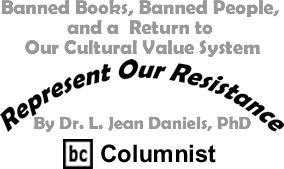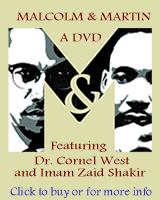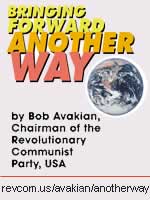
|
|||||||||||||||||||||
|
||||||||||
|
||||||||||
The current issue is always free to everyone If
you need the access available to a |
||||||||||
 |
||||||||||
 |
||||||||||
I stopped in the Lakeview Branch to pass along a flyer. The librarian pointed behind me, and I turned around to see a display of books including the book named on my flyer. The librarian said that these were “challenged or banned” books. I had in my hand flyers announcing my attempt to get a community of readers together to read and discuss Toni Morrison’s Beloved. This is Banned Books Week 2007, September 29 to October 6, 2007, as part of the American Library Association’s (ALA) twenty-sixth annual celebration “of the freedom to read.” According to the sponsors, “this freedom, not only to choose what we read, but also to select from a full array of possibilities, is firmly rooted in the First Amendment to the U.S. Constitution, which guarantees freedom of speech and freedom of the press.” I think of Black slaves like Fredrick Douglass’s subversive defiance of the law when he learns to read. The ad continues: while these challenges are motivated by a desire to protect children, “this method of protection [challenging and banning texts] contains hazards far greater than exposure to the ‘evil’ against which the protection is leveled.” I am disturbed by this word “evil” in the context of a discussion about challenged and banned books. “Evil” is what? Who determines the definition of “evil” and for what purpose? What form does it take? Historically, what form has been given to represent “evil”? “Evil” has been thought of as the unknown, the unfamiliar, the wilderness, the lawless, the shadowy, the ungodly, and the blackness of nightmares and of people. In Euro-American literature, the blackness of nightmares have represented, as Harry Levin (The Power of Blackness: Hawthorne, Poe, Melville) has noted, the “visitations of insecurities” where blackness penetrates, invades, encircles whites. The “power of blackness” has been a “touchstone,” the works of Shakespeare, Hawthorne, Melville, and others. To use Levin’s phrase, white writers of the Euro-American literary tradition have been connoisseurs of blackness. From this lingering in “blackness” emerges what Toni Morrison (Playing in the Dark: Whiteness and the Literary Imagination) calls “impenetrable” images of whiteness” that begin to appear in conjunction with “the representations of black or Africanist people who are dead, impotent, or under complete control…” Morrison continues: "these images of blinding whiteness seem to function as both antidote for and meditation on the shadow that is companion to this whiteness — a dark and abiding presence that moved the hearts and texts of American literature with fear and longing. This haunting, a darkness from which our early literature seemed unable to extricate itself, suggests the complex and contradictory situation in which American writers found themselves during the formative years of this nation’s literature." In literature, darkness, blackness, “evil” takes the representation of those African enslaved bodies rather than the reflection of internal “blackness” in the white subjugation of human beings. The transference of “internal conflicts,” Morrison writes, to a “blank darkness” bounds and “violently silenced black bodies.” This subject, she concludes, becomes “a major theme in American literature.”
Literature is not an “innocent” use of words or creation of images. As a crucial cultural production by which individuals come to recognize themselves and others, literature has always been political, ideological, and therefore an influential tool for evading blackness within by focusing attention on blackness without. Ultimately, we are talking about a process of suppressing cultural difference, dissent, normalizing marginalization or even extermination in the physical sphere while establishing the literary representations of whiteness. Formal “education” engages in evasion, rendering silent, suppressing “blackness," even if the participants can’t articulate why or recognize the origins of this practice. The Black literary tradition precedes the American literary tradition and has its origins in the African traditions. As a Diaspora tradition, its texts feature the “blackness” of subjugation, colonialism, slavery, exploitation, inequality, and injustice — evaded topics in the romantic/Gothic representation of whiteness. Consequently, as a collective of Black literary traditions, Black American literature has a unique role in the edification of American’s Empire agenda. At the communal level, it serves to educate Black people in the ways we have survived what Marimba Ani (Yurugu) calls the Maafa, by offering a way to demystify the “impenetrable” image of whiteness. Black literature, then, ultimately speaks of and to the Spirit of Black people on this earth. A day after my encounter with the display of challenged and banned books at the local library, I heard a representative from the ALA, the “progressive” radio. Apparently, the ALA will sponsor local readings of these banned books. At one point, the host asked her why books were challenged or banned. She answered that often the context contained elements that the censors found, to use her word, “dirty.” She assured the listeners that unlike some “professors” who focus on the “dirty” parts, the ALA readings would focus on “literature”! I suspect reading only “literature” and not the “dirty” parts refers to reading the description of leaves blowing on some trees — not that one in Jena, Louisiana; they hurried and cut that one down: we will just cut down the tree where the “evil” nooses hung, thus protecting our children from confrontation with “blackness” via Black people’s response. As the source narrative for the La Salle Parish District Attorney Reed Walters and the mainstream media, whiteness eliminates its “dirty” parts and reigns free of retribution. Did I say that there are a significant number of key Black literature texts listed on the ALA “challenged and banned” books list for 2007? Well, of course, and not by accident. Someone will say that there are a number of texts written by whites on the list too. But thanks to white privilege, white children will not suffer a short of texts written by whites. But Black children are forced to be connoisseurs of whiteness, images that dehumanize, abuse, and exclude them. With censorship on Black literary texts, they are told to deal with it in this police state. The “challenged and banned” books written by Black authors include Toni Morrison’s Bluest Eyes, and Song of Solomon. Maya Angelou’s I Know Why the Caged Bird Sings, Alice Walker’s The Color Purple, Richard Wright’s Native Son, Gordon Park’s The Learning Tree, Ernest J. Gaines’ The Autobiography of Miss Jane Pitman, and Dean Walter Myers’ Fallen Angels. I am surprised that the actual slave narratives are not included on this list — after all Sojourner Truth’s autobiography notes that she exposes her breast in public, and in Incidents of a Slave Girl, Harriet Jacobs recounts how she had to seduce another slaveholder and bears children by him in order to retain control over her body. These books, according to the censors, employ “offensive” language or contain “sexual content.” Never mind that throughout this nation, children engage video games or blogs with offensive language and sexually graphic images — gratuitous violence as a matter of normalcy! Never mind that a few of them in Jena, Louisiana could string up three nooses to a tree and the authorities did not find this behavior “offensive.”
And yes — one of the books on display at that library and on the list is Beloved. As we know, Beloved is filled with “dirty” parts… the hanging of those boys from the “most beautiful sycamores in the world” or the jagged saw that crossed “crawling” baby’s neck or taking the milk from a prone Black woman. They can’t wrap their minds around that first image in the barn, of Schoolteacher and his nephews surrounding that Black woman. Too much for their children to see! It is too much for their innocence to see Sethe in that second barn passing that saw across her baby girl’s neck… "They could dirty you," Sethe says to Denver, "more than work, kill, or maim you, but dirty you. Dirty you so bad that you couldn’t like yourself anymore. Dirty you so bad you forgot who you were and couldn’t think it up.” And get away with it! “Evil” and “dirty” parts are certainly not unrelated, are they? Bodies left to float in the Ninth Ward of New Orleans for days while the world watched on. The attempt to expel from the narrative of innocence the very “dirty” image of nooses hung on a tree with whitewashing words: “teenage pranks.” By banning the reading of Beloved, are the censors suggesting that the rape and milking of Sethe by Schoolteacher’s nephews is irrelevant now? Are white and Black children to chalk those past crimes against Black women as mere “teenage pranks”? If there are two Black literary texts on the list, there’s two narratives of the Maafa (the disaster) too many. These would be two narratives less that could serve as anchors for our children’s spirits. We can’t afford to look at these occurrences of the narrative of whiteness at work as isolated incidents. These narratives of whiteness form a collective of socializing thought and behavior embedded in the U.S. Empire agenda. It is not an accident that Malcolm X, the Black Panthers, and outspoken Blacks in the 1960s and 1970s ended up in graves, in exile, in prison, or in historical narratives that featured them as “militant,” “criminal” and therefore “violent” at the same time Black women like Toni Morrison, Alice Walker, Nikki Giovanni, Audre Lorde, and Maya Angelou were writing the Black contemporary experience in continuum with the Black literary tradition. With the U.S. under Nixon and then Reagan leadership well on its way to fulfill its Pax Americana dream, Blacks who reminded this nation about its responsibilities to follow through on its promise of equality and justice had to be eradicated literally or figuratively. In the meantime, our children are not educated with the knowledge to either arm or defend themselves in a social system that has determined them worthless unless profit can be acquired from their imprisonment. The challenging and banning of the Black literary tradition is fundamental to the process of eliminating blackness, that is, Black people. Yet, there are Blacks and whites who refuse to recognize these connections as evidence of an ideological agenda to maintain whiteness on a global level. In a city with one of the highest per capita Ph.D. populations, it is still necessary for me to explain that my “opinions” are not solely the singular expression of one Jean Daniels but based on the collective conditions and lived experiences of other Blacks in the U.S. But, alas, where are the intellectual articulations of Black Americans? How are they differentiated by those with an interest in preserving the hegemony of whiteness? How are we differentiated in the media?
We are criminals, violates of all American traditions and values. Therefore, crime is labeled Black. Everyone hears on the news, “a Black man killed…” Blacks understand that “a man killed…” means a white man killed someone. Criminality is identified as Black, something Black people do. That is what people hear. They do not hear in the “absence” of Black people crime, “evil,” or dirtiness. Thus, the rest of the news refers to the killing and suffering of hundreds adding up to thousands and then millions of people around the world by the white U.S. hegemonic power. How many children died from lack of milk and food because of U.S. economic sanctions? That is news too. But it is not heard as racial — and yet, what else is it? The victims experiencing hunger are Black and Brown skinned people, but white Americans don’t see themselves as a collective race responsible for slaughter and suffering on a daily bases. As “whiteness,” they are “everybody” in general and “nobody” in particular. And even in this thinking is the collective acceptance of an ideology that speaks of white privilege as an entitlement to dominance and a right to evade responsibility for any crime against humanity. Don’t pay any attention to the man behind the white curtain, the biggest gun dealer and drug dealer in the world. Focus your anxieties and fears on the Black, Brown, Red, and Yellow figures right around you! In the meantime, the U.S. military patrols the world, knocks down doors of the homes of Iraqi citizens looking for “terrorists” while, domestically, the state police apparatus in city after city is given carte blanche to apprehend and imprison the “usual suspects of crime.” “Alleged rise in crime…in portions of the west side” of Madison, Wisconsin, according to the editor of the City Capital Hues (CCH), has prompted the mayor and the police department to commence a “surge” in police surveillance and ticketing “in the suppression zone.” The editor, responding to an article published in the Wisconsin State Journal (WSJ), challenged remarks made by West District Capt. Jay Lengfeld who strongly suggested that it was “the newcomers from Chicago” causing the increase in crime. “People from Chicago,” according to Lengfeld “are used to it being noisy at night.” The police chief, who is Black, observed that while “race or ethnicity” were not mentioned, of the eight hundred present at this meeting regarding safety on the west side, only “a dozen people of color” were in attendance! A familiar narrative of whiteness confronting its Gothic nightmare, re-constructed for a particular audience who are nonetheless “educated” to read race, specifically Black in the place of “people” in the phrase “people from Chicago.” In the Wisconsin State Journal article, Lengfeld said he noted a “difference in customary bedtimes and patterns of supervision of children.” And these people, Lengfeld added, congregate outside on front porches instead of backyards: “People in big cities socialize in groups in front of their houses in their neighborhoods…Going into the backyards is formal, although it may seem more normal to you and I (sic).” The editor of the CCH reminded Madisonians that good-paying factory jobs have been shipped over seas, and there’s an ever-increasing gap between high income and low income households. In addition, he stated “while most of our community has the good life, others are living in recession.” With the rising price of energy, my editor writes, “air conditioning” or trips to the Vilas Zoo may be the reason people congregated on front porches — not that they are engaging in drugs or some other crime. “What’s going to happen when the police start writing more tickets to low-income people living in the ‘suppression zone,’” he asked. The increase in crime, he argued, is not caused by Blacks “from Chicago.” He was right to point out, however, that “a diversity of African American people,” painted with the stereotype of “those people from Chicago,” will be “treated negatively as “those people from Chicago” no matter what the situation,” for the phrase will come to identify all six percent of the Black population in Madison, the editor concluded. I might add that this is a college town with a huge pre-dominantly white college-aged population. Are we to believe that the dorms and campus apartments are zones free of drugs and crimes or just free to pursue the agenda of whiteness? These young adults within this physical locale are protected, like the children K-12, by a narrative free of the “evil” and “dirty” parts, with a fresh white coat of paint!
There’s no defense for it, Baby Suggs tells her granddaughter. We defeat the narratives of whiteness by regaining control over our cultural traditions. The Maafa, writes Ani, “has disconnected us from our cultural origins, we have remained vulnerable in a social order that does not reflect our cultural identity.” But we must go on… “The answer to our social dilemma,” Ani continues, “is the resocialization of our people into the cultural value-system that affirms our spiritual being. Our Ancestors are calling us ‘home’ back to our cultural selves. We must begin the process of Sankofa.” BlackCommentator.com Columnist Dr. Jean Daniels writes a column for The
City Capital Hues in Madison Wisconsin and is a Lecturer
at |
||||||||||
| October
4,
2007 Issue 247 |
|
| Printer Friendly Version in resizeable plain text format format |
 |
 |
 |
| |
| |




































